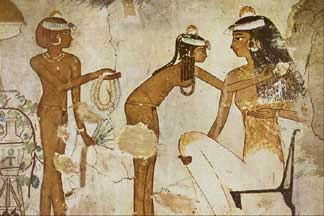Peasants and Slaves in Ancient Egypt
Peasants comprised as much as eighty percent of the Egyptian population (David 1998, pg 91). The majority of peasants worked in the fields producing crops, while some worked as servants in the homes of wealthy nobles. During the flooding season, which lasted up to three months, peasants often worked on large building projects for the government.
 Slaves were most commonly prisoners of war. Although the pyramids are often depicted as being built by slaves, there is little historical evidences of this. The historical evidence suggests that farmers and other workers were employed during the flood season to erect the pyramids and other large building projects. It was not until the Middle Kingdom that large groups of slaves were present in Egypt. During the Old Kingdom, when the pyramids were built, there is no evidence that Egypt maintained a large population of slaves.
Slaves were most commonly prisoners of war. Although the pyramids are often depicted as being built by slaves, there is little historical evidences of this. The historical evidence suggests that farmers and other workers were employed during the flood season to erect the pyramids and other large building projects. It was not until the Middle Kingdom that large groups of slaves were present in Egypt. During the Old Kingdom, when the pyramids were built, there is no evidence that Egypt maintained a large population of slaves.
Slaves did not hold the same status in Ancient Egypt as slaves did during the time of the European expansion. For example, slaves could own land, marry freeborn people, and even employ servants. Slavery in Egypt did not mean total ownership, which is associated with the later concept of slavery.
Egyptian Social Pyramid
Pharaoh Vizier Nobles Scribes Government Workers
Workers Farmers Peasants & Slaves

